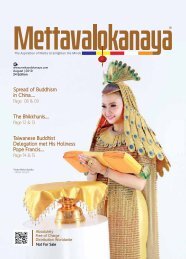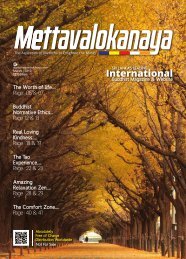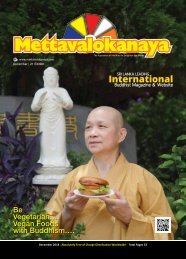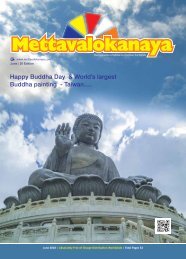#Mettavalokanaya_International_Buddhist_Magazine_May_2021
This is the World’s Most Popular & Leading Monthly International Buddhist Magazine, “Mettavalokanaya” on May 2021 Vesak Edition - 31. https://mettavalokanaya.com/magazine-31/ http://www.mettavalokanaya.com/
This is the World’s Most Popular & Leading Monthly International Buddhist Magazine, “Mettavalokanaya” on May 2021 Vesak Edition - 31.
https://mettavalokanaya.com/magazine-31/
http://www.mettavalokanaya.com/
You also want an ePaper? Increase the reach of your titles
YUMPU automatically turns print PDFs into web optimized ePapers that Google loves.
Loving
Kindness with
Vipassana...
Once the meditator is wellestablished
in the basics
of vipassana meditation,
loving-kindness meditation
(Metta bhavana) can be brought
in to support the more demanding
vipassana practice. While this is
switching meditation modes to a
concentration-based practice, its
benefit is that it uplifts and sweetens
the mind and helps the meditator to
cope with negative emotions that
they are not yet able to deal with
in their vipassana practice. Having
cultivated sufficient loving-kindness
to overcome negatives in the mind,
the meditator then can switch back
to vipassana mode. The reverting
back to vipassana mode is done by
investigating the qualities of the
mind-state that has been induced by
loving-kindness, thereby changing to
the vipassana mode of watching the
particular characteristic of the mindstate
that developed from the lovingkindness
meditation.
Loving-kindness is a meditation
practice that specifically retrains
the mind to overcome all forms of
negativity. It brings about positive
attitudinal changes by systematically
developing the quality of ‘lovingacceptance’.
It is the qualities of
acceptance and receptivity that
create the spaciousness and clarity
of mind that allows for deepening
attentiveness. That is why combining
loving-kindness with vipassana is
very supportive of the meditator’s
ongoing practice. Loving-kindness
can be developed, either to give the
benefit of supporting and/or clearing
the way for vipassana meditation,
or it can be further developed, in a
more systematic way, to achieve a
level of meditative absorption or one
pointedness. When loving-kindness
meditation is developed systematically
to the level of meditative absorption
or one-pointedness, the five
absorption factors of concentration
are developed. The first two are
causal factors applied thought and
sustained thought, followed by three
effects rapture, ease-of-mind and onepointedness
or unification of mind. It is
not really necessary to develop lovingkindness
to the absorption level, but
it can be useful for the meditator to
be familiar with the absorption factors,
as some of them will arise during
vipassana meditation as well. And
being familiar with the concentration
effects, the pure vipassana meditator
is less likely to get attached to them
when they arise.
The advantages of having
gained the five absorption factors is
that they counteract the five mental
hindrances or the obstacles for the
meditator; but the pure vipassana
meditator should be aware, that
threshold concentration is sufficient
to inhibit the hindrances as well. The
five absorption factors and how they
neutralize the five mental hindrances:
— Applied thought, by arousing energy
and effort, overcomes the hindrance
of sloth and torpor or mental inertia;
— Sustained thought, by steadying
Deep
Concentration
the mind, overcomes skep-tical
doubt, which has the characteristic
of wavering; — Rapture, with its
uplifting effervescence, prevails over
feelings of ill-will; — Ease-of-mind,
by relieving accumulated stress,
counteracts restlessness or agitation
of mind; — One-pointedness holds
the mind’s wanderings in the sensefields
to inhibit sensuality. Because
of its auto-suggestive nature, the
positive attitude of loving-kindness,
combined with deep concentration,
will imprint the new positive
conditioning to override old negative
patterns.
For example, the overly critical
mind, which finds fault with anything
and everything, is reprogrammed
to be more accepting and allowing.
So on the psychological level, the
therapeutic benefits for the individual
are considerable as old negative
habits are broken and are replaced
with new positive ways of thinking.
Loving-kindness is practiced as
the first of a series of meditations
that produce four qualities of love:
Friendliness (metta), Compassion
(karuna), Appreciative Joy (mudita) and
Equanimity (upekkha). The quality of
‘friendliness’ is expressed as warmth
that reaches out and embraces others.
Most Venerable
Pannyavaro Maha Thera
Resident Teacher, Founder
and Abbot of Bodhi Tree
Forest Monastery and
Community Retreat Centre in
Northern New South Wales,
Australia.
When loving-kindness matures it
naturally overflows into compassion,
because it empathizes with people’s
difficulties; while on the other hand
one needs to be wary of pity, as its
the near enemy, merely mimicking the
quality of concern without empathy.
The positive expression of empathy is
an appreciation of other people’s good
qualities or good fortune rather than
feelings of jealousy towards them,
which is the enemy of appreciative joy.
This series of meditations comes
to maturity in the state of on-looking
equanimity. This equanimity has to
be cultivated within the context of
this series of meditations or else it
tends to manifest as its near enemy,
indifference or aloofness. It remains
caring and on looking with an equal
spread of feeling and acceptance
toward all people, relationships and
situations without dis-crimination.
The structure of the practice is fairly
simple. The meditator must start
with generating loving-feelings and
acceptance towards himself or herself.
This is very important, as one needs
to have loving feeling towards oneself
before it can be projected towards
others. Then one induces positive
emotional feelings of loving-kindness
towards four types of people, after
which, one directionally pervades
the loving-feeling to all points of
the compass. The final stage is nonspecific
pervasion, which more or
less arises spontaneously as the
concentration intensifies and there is
little or no self-referencing.
As loving-kindness is a
concentration-based meditation one
must not allow the mind to wander—
when it does, gently bring it back. The
time you need to spend doing this
practice would depend on the time
it takes to arouse the loving feelings.
At least a half-hour session would be
needed for the practice to develop
sufficiently. The practice must always
start with developing loving acceptance
of oneself. However, if resistance
is experienced, then it indicates that
feelings of unworthiness are present.
Don’t worry, as this indicates there is
simply work to be done. Essentially you
are working with a quality of mind, and
as the practice is auto-suggestive, any
quality of mind, positive or negative
can be changed. In good time, and
with persistent practice, feelings of
self-doubt and negativity can be
overcome. Then you can move on to
develop loving-kindness to others.
16 l Mettavalokanaya l May l 2021 2021 l May l Mettavalokanaya l 17
















